美国联邦政府结构
联邦和州的分权表
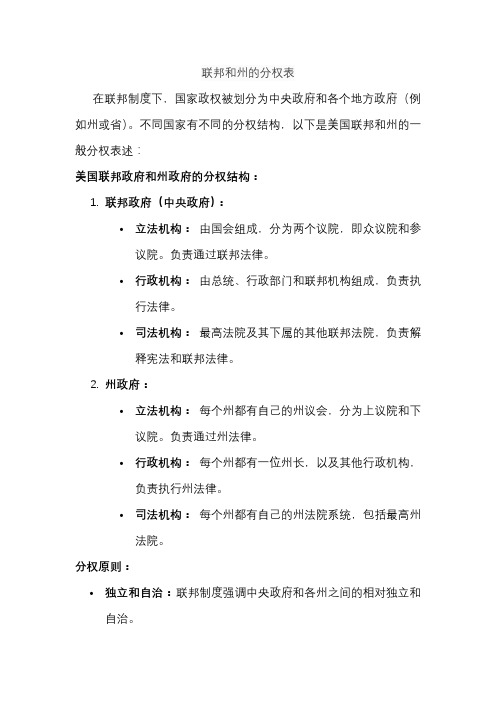
联邦和州的分权表
在联邦制度下,国家政权被划分为中央政府和各个地方政府(例如州或省)。
不同国家有不同的分权结构,以下是美国联邦和州的一般分权表述:
美国联邦政府和州政府的分权结构:
1.联邦政府(中央政府):
•立法机构:由国会组成,分为两个议院,即众议院和参议院。
负责通过联邦法律。
•行政机构:由总统、行政部门和联邦机构组成,负责执行法律。
•司法机构:最高法院及其下属的其他联邦法院,负责解释宪法和联邦法律。
2.州政府:
•立法机构:每个州都有自己的州议会,分为上议院和下议院。
负责通过州法律。
•行政机构:每个州都有一位州长,以及其他行政机构,负责执行州法律。
•司法机构:每个州都有自己的州法院系统,包括最高州法院。
分权原则:
•独立和自治:联邦制度强调中央政府和各州之间的相对独立和自治。
•共享权力:联邦和州政府在一些领域有共享的权力,例如税收、国防等。
•宪法限制:宪法规定了中央政府和各州的权力和责任,同时保护了个人的权利。
总体而言,美国的分权结构是基于宪法的原则,旨在保护个人自由、避免滥权,并促进中央和地方政府之间的合作。
其他国家的联邦和地方分权结构可能有所不同,取决于各自的宪法和法律体系。
美国政府结构以及对我国的启示
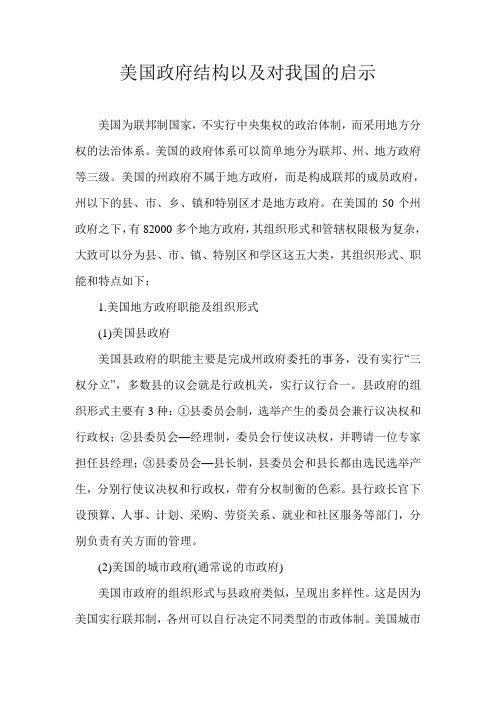
美国政府结构以及对我国的启示美国为联邦制国家,不实行中央集权的政治体制,而采用地方分权的法治体系。
美国的政府体系可以简单地分为联邦、州、地方政府等三级。
美国的州政府不属于地方政府,而是构成联邦的成员政府,州以下的县、市、乡、镇和特别区才是地方政府。
在美国的50个州政府之下,有82000多个地方政府,其组织形式和管辖权限极为复杂,大致可以分为县、市、镇、特别区和学区这五大类,其组织形式、职能和特点如下:1.美国地方政府职能及组织形式(1)美国县政府美国县政府的职能主要是完成州政府委托的事务,没有实行“三权分立”,多数县的议会就是行政机关,实行议行合一。
县政府的组织形式主要有3种:①县委员会制,选举产生的委员会兼行议决权和行政权;②县委员会—经理制,委员会行使议决权,并聘请一位专家担任县经理;③县委员会—县长制,县委员会和县长都由选民选举产生,分别行使议决权和行政权,带有分权制衡的色彩。
县行政长官下设预算、人事、计划、采购、劳资关系、就业和社区服务等部门,分别负责有关方面的管理。
(2)美国的城市政府(通常说的市政府)美国市政府的组织形式与县政府类似,呈现出多样性。
这是因为美国实行联邦制,各州可以自行决定不同类型的市政体制。
美国城市政府的组织形式主要有三种:①市长—议会制。
这种体制以分权为原则,市长行使执行权,市议会行使立法权。
这种体制内部有强市长型和弱市长型两种不同情况;②市议会—经理制。
小城市较多地实行这种市政体制。
市议会行使议决权,并公开招聘一位专家任市经理,授予市经理统一指挥市政府工作的全权,包括独立任免政府部门首长的权力;市议会议长兼市长,但只有礼仪性的职权;③市委员会制。
市委员组成市委员会,市委员会既是议会又是政府,每位委员既是议员又兼任若干个政府部门的首长,委员们推选其中一位主持会议,他就是市长,若轮流主持,市长就轮流担任。
市长没有否决权,只有一些礼仪性的职权。
[4](3)其他美国的乡镇由于人口不多,一般不设代议机构,乡镇民大会议决公共事务。
美国行政体制

美国行政体制美国行政体制一、概述美国行政体制是由多级政府组成的体制,包括联邦政府、州政府和地方政府。
美国行政体制的核心特点是分权和制衡。
下面将详细介绍美国行政体制的组成部份和各级政府的职责。
二、联邦政府1. 行政部门(1) 总统办公室:负责总统和副总统的日常事务管理。
(2) 内阁:由总统任命的各部长组成,负责制定和执行政府政策。
(3) 各部门:包括国务院、财政部、国防部等,负责特定领域的事务管理。
2. 立法部门(1) 国会参议院:由各州的参议员组成,负责通过立法和审查联邦政府行为。
(2) 众议院:由直接选举产生的代表组成,负责代表人民意愿制定法律。
3. 司法部门(1) 最高法院:最高行政法庭,负责解释联邦法律和参预联邦政府之间的纠纷。
(2) 联邦巡回上诉法院:审理来自各地的上诉案件。
(3) 联邦地方法院:审理联邦法律和涉及联邦政府的案件。
三、州政府1. 行政部门(1) 州长办公室:由州长和其工作人员组成,负责州政府的日常事务管理。
(2) 各部门:包括教育部、卫生部、交通部等,负责特定领域的事务管理。
2. 立法部门(1) 参议院:由州参议员组成,负责通过立法和审查州政府行为。
(2) 众议院:由直接选举产生的代表组成,负责制定和修改州法律。
3. 司法部门(1) 最高法院:州最高行政法庭,负责解释州法律和参预州政府之间的纠纷。
(2) 州上诉法院:审理来自地方法院的上诉案件。
(3) 地方法院:审理州法律和涉及州政府的案件。
四、地方政府1. 县政府:负责管理特定县的事务,包括教育、卫生、运输等。
2. 市政府:负责城市内的日常事务管理,包括警察、消防、城市规划等。
3. 镇政府:负责农村地区的事务管理,包括土地使用规划、基础设施建设等。
附件:本所涉及的附件如下:1. 美国宪法2. 联邦政府部门职责细则3. 州政府部门职责细则法律名词及注释:1. 分权:指权力在不同政府层级之间分散,以制衡权力滥用。
2. 制衡:指不同政府部门之间相互制约,保证权力的均衡与合理运行。
重点讲解 用组织结构图显示美国的三权分立制

用组织结构图讲解美国的三权分立制山东曹县第三中学苏长荣邮政编码:274400一、三种权力之间的相互分立三权分立是美国联邦政府组建和运行的基本原则,其核心内容是权力分立、制约和平衡。
中央政权机关由彼此平等而又独立的立法、行政和司法三个机关组成,立法权属于国会,行政权属于总统,司法权属于联邦各级法院。
国会负责立法,总统负责实施法律,法院负责审查法律。
如下面图片1所示:图片1二、三种权力之间的相互制衡。
三种权力之间又是相互制衡的。
对行政权的制约表现在:行政权属于总统,但是行政机构的设置和所需经费须由国会批准,国会还有权监督行政执行情况、经费开支和官员行为。
美国最高法院可以宣布总统发布的行政命令、行政机关颁布的规章条例违宪;还能通过案件的判决对宪法作出新解释,扩大或限制总统的权力。
对立法权的制约表现在:美国立法权属于国会,但是总统有权否决国会立法;可以发布拥有法律效力的行政命令;还有立法倡议权,即建议国会立什么样的法律。
法院有权宣布国会制定的法律违反联邦宪法。
对司法权的制约表现在:司法权属于法院,但是法官由总统提名经参议院同意后任命;最高法院法官人数和联邦其他法院的设立,均由国会决定,总统亦可施加影响。
国会可以通过批准对法官的任命或弹劾法官的办法,来改变法院的组成。
国会和各州一起,可以用宪法修正案推翻最高法院的裁决。
如下面图2 所示图片2三权之间的权力既有分立又有交叉,相互制衡,如下面图3所示。
图片3三、三权分立制的含义及实质国家的立法权、行政权和司法权分别由议会、政府、法院独立行使,同时又相互制约,保持权力均衡,按照这种权力分立和权力制衡的原则来组织国家机关、行使国家权力的制度,被称为“三权分立制”。
这种制度本质上是一种资产阶级民主制度,按照三权分立原则组织国家机构,可以防止少数人专权,使民主制度不至于转变为专制制度。
这有利于反对封建专制,调节资产阶级内部各集团的利益,它有效地维护了资产阶级的统治。
但是,它也有明显的弊端,三大权力机关之间互相扯皮,导致效率低下。
美国政府机构设置
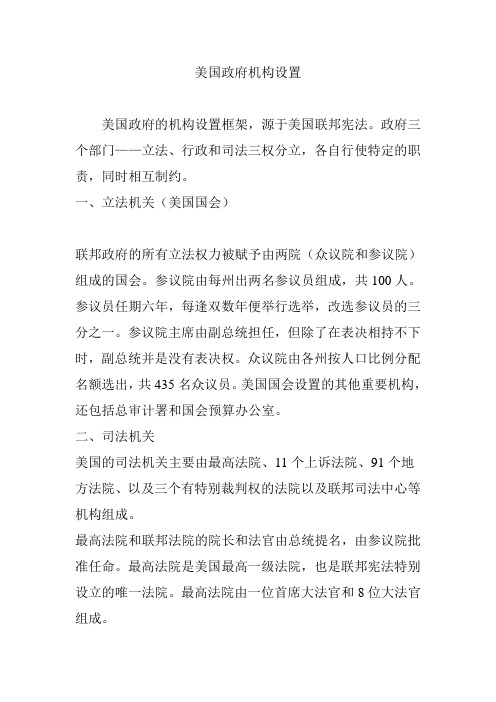
美国政府机构设置美国政府的机构设置框架,源于美国联邦宪法。
政府三个部门——立法、行政和司法三权分立,各自行使特定的职责,同时相互制约。
一、立法机关(美国国会)联邦政府的所有立法权力被赋予由两院(众议院和参议院)组成的国会。
参议院由每州出两名参议员组成,共100人。
参议员任期六年,每逢双数年便举行选举,改选参议员的三分之一。
参议院主席由副总统担任,但除了在表决相持不下时,副总统并是没有表决权。
众议院由各州按人口比例分配名额选出,共435名众议员。
美国国会设置的其他重要机构,还包括总审计署和国会预算办公室。
二、司法机关美国的司法机关主要由最高法院、11个上诉法院、91个地方法院、以及三个有特别裁判权的法院以及联邦司法中心等机构组成。
最高法院和联邦法院的院长和法官由总统提名,由参议院批准任命。
最高法院是美国最高一级法院,也是联邦宪法特别设立的唯一法院。
最高法院由一位首席大法官和8位大法官组成。
每个上诉法院有3-15名上诉法官。
地区法院是联邦法院系统的基层法院,每一地区法院有1-27 个法官。
三、行政部门机构设置美国总统领导的行政部门分为两部分:总统的办事机构和联邦政府的各部。
(一)总统和白宫1、总统2、总统内阁内阁成员由处理具体的国家及国际事务各部部长和总统指定的其他官员组成。
除副总统和国务卿外,还包括13个部的部长3、白宫“政研室”1)国家安全委员会主席由总统担任,其他法定成员包括副总统、国务卿和国防部长。
国家安全委员会帮助总统制定有关国家安全的国内外军事、情报和经济政策。
2)总统经济顾问委员会委员会由主席1人和委员2人组成。
委员会主席也称为总统首席经济顾问。
委员会的三名成员都由美国总统任命,并经参议院同意。
委员会有专业工作人员19名,任期1-2年。
其任务是:为总统分析全国经济情况,为制定国内外经济政策提供建议,协助总统准备提交国会的年度经济报告,为总统收集经济发展与动向的情报,评价联邦政府的各项经济政策与活动等。
美国的行政架构
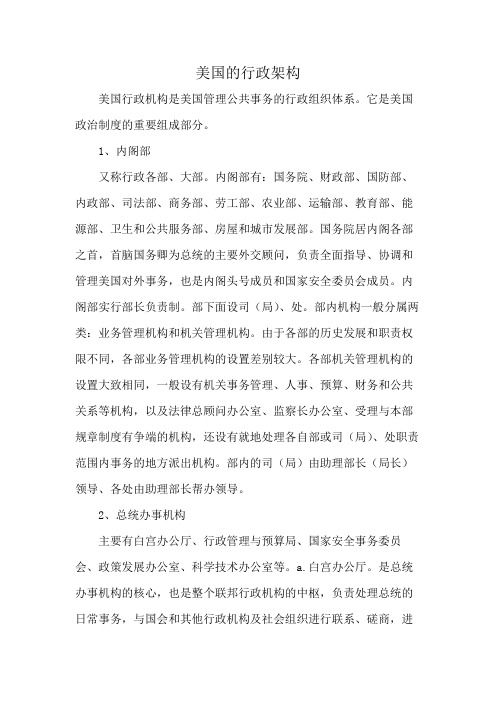
美国的行政架构美国行政机构是美国管理公共事务的行政组织体系。
它是美国政治制度的重要组成部分。
1、内阁部又称行政各部、大部。
内阁部有:国务院、财政部、国防部、内政部、司法部、商务部、劳工部、农业部、运输部、教育部、能源部、卫生和公共服务部、房屋和城市发展部。
国务院居内阁各部之首,首脑国务卿为总统的主要外交顾问,负责全面指导、协调和管理美国对外事务,也是内阁头号成员和国家安全委员会成员。
内阁部实行部长负责制。
部下面设司(局)、处。
部内机构一般分属两类:业务管理机构和机关管理机构。
由于各部的历史发展和职责权限不同,各部业务管理机构的设置差别较大。
各部机关管理机构的设置大致相同,一般设有机关事务管理、人事、预算、财务和公共关系等机构,以及法律总顾问办公室、监察长办公室、受理与本部规章制度有争端的机构,还设有就地处理各自部或司(局)、处职责范围内事务的地方派出机构。
部内的司(局)由助理部长(局长)领导、各处由助理部长帮办领导。
2、总统办事机构主要有白宫办公厅、行政管理与预算局、国家安全事务委员会、政策发展办公室、科学技术办公室等。
a.白宫办公厅。
是总统办事机构的核心,也是整个联邦行政机构的中枢,负责处理总统的日常事务,与国会和其他行政机构及社会组织进行联系、磋商,进而拟定有关政策。
b.行政管理与预算局。
是非党派机构,协助总统编制、执行联邦预算,推进行政改革。
c.国家安全事务委员会。
负责向总统提供与国家安全有关的内政、外交和军事方面的总体政策。
d.政策发展办公室。
负责协助总统拟定和协调国内政策的各种选择方案,并检查政府的主要国内政策。
e.科学技术办公室。
负责分析和鉴定政府有关科技、工程方面的主要政策、规划和计划项目,协助总统领导和协调各部门的科技发展。
其他总统办事机构也都是总统某方面行政决策的助手,发挥咨询、协调和监督功能。
3、独立机构是为完成政府专业管理和专门任务而设立的行政机构,占联邦行政机构的比例最大。
美国政治结构
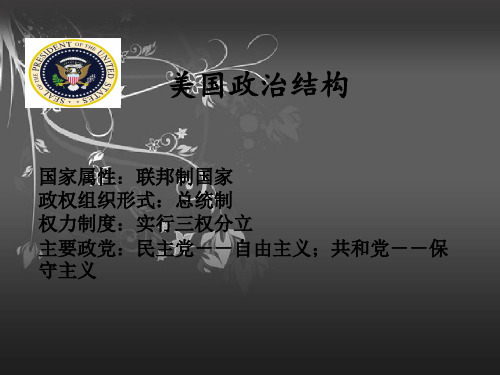
国家属性:联邦制国家 政权组织形式:总统制 权力制度:实行三权分立 主要政党:民主党--自由主义;共和党--保 守主义
联邦政府 美国的国家组织是依据三权分立与联邦制度、二大政治思想而制定, 当
初在起草宪法时因恐权力过分集中于个人或某一部门将危害人民的自由, 因而 将立法、司法, 行政三种权力分别独立, 互相制衡, 以避免政府滥权, 根据 宪法: 立法机关是参议院与众议院并设二院制议会, 司法机关以联邦最高法院 为首下设11个控诉法院, 95个地方法院及4个特别法庭。 行政机关是以由人民 直接选举的总统为最高行政首长, 并以副总统辅之, 下设行政部门。 政府的 权力有联邦政府、州政府之分, 宪法起草人根据政府必须接近百姓才不致剥夺 人民自由的原则, 将有关各州自治权保留给州政府, 各州政府本身拥有立法、 司法、行政诸权限, 联邦政府的权力系以一州政府无法单独行使者为限, 如课 税、财政、国防、 外交、货币银行、出入境管理、对外贸易、国民福利、邮政 , 以及科学艺术的发展援助等。
金会、武器管制及裁军总署、联邦邮政总局、美国国际交流总 署等。
经营范围 司法
美国的司法权力, 赋予一个最高法院, 以及国会可以随时制定及设立的次等法院
上诉 法院
最高 法院
地方 法院
特别 法庭
立法
经营范围
根据美国宪法第一条, 联邦政府将所有立法权力赋予参议院及众 议院组成的国会, 参议院由每州二名议员组成, 众议院议席按每 州人中多寡而定, 每五十万人选举一名众议员, 但保障每州至少 有一名, 目前有六州: 阿拉斯加、内华达、德拉华、北达科他、佛 蒙特及怀俄明等只有一名众议员, 相反的加利福尼亚州就有四十三 名众议员。 早期的国会议员并非由人民直接选举, 一直到一九一 三年通过的宪法第十七条修正案才规定参议院由人民直接投标选举, 宪法规定, 美国参议员必须至少年满三十岁, 成为美国公民至少 有九年, 众议员须至少廿五岁,成为美国公民至少七年, 二者均 需属所代表之各州的居民, 州议会把州划分为数个国会选区, 每 区的选民每二年选出一名众议员, 每逢双数年份便举行全国性的选 举选出参议员。 由于参议员的任期为六年, 故实际每二年仅改选 参议院的三分之一议席以避免国会的功能因改选而中辍。
美国行政体制
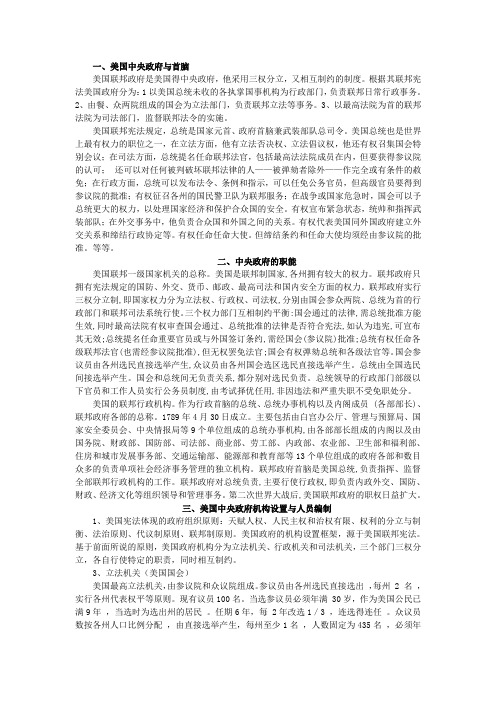
一、美国中央政府与首脑美国联邦政府是美国得中央政府,他采用三权分立,又相互制约的制度。
根据其联邦宪法美国政府分为:1以美国总统未收的各执掌国事机构为行政部门,负责联邦日常行政事务。
2、由餐、众两院组成的国会为立法部门,负责联邦立法等事务。
3、以最高法院为首的联邦法院为司法部门,监督联邦法令的实施。
美国联邦宪法规定,总统是国家元首、政府首脑兼武装部队总司令。
美国总统也是世界上最有权力的职位之一,在立法方面,他有立法否决权、立法倡议权,他还有权召集国会特别会议;在司法方面,总统提名任命联邦法官,包括最高法法院成员在内,但要获得参议院的认可;还可以对任何被判破坏联邦法律的人——被弹劾者除外——作完全或有条件的赦免;在行政方面,总统可以发布法令、条例和指示,可以任免公务官员,但高级官员要得到参议院的批准;有权征召各州的国民警卫队为联邦服务;在战争或国家危急时,国会可以予总统更大的权力,以处理国家经济和保护合众国的安全。
有权宣布紧急状态,统帅和指挥武装部队;在外交事务中,他负责合众国和外国之间的关系。
有权代表美国同外国政府建立外交关系和缔结行政协定等。
有权任命任命大使。
但缔结条约和任命大使均须经由参议院的批准。
等等。
二、中央政府的职能美国联邦一级国家机关的总称。
美国是联邦制国家,各州拥有较大的权力。
联邦政府只拥有宪法规定的国防、外交、货币、邮政、最高司法和国内安全方面的权力。
联邦政府实行三权分立制,即国家权力分为立法权、行政权、司法权,分别由国会参众两院、总统为首的行政部门和联邦司法系统行使。
三个权力部门互相制约平衡:国会通过的法律,需总统批准方能生效,同时最高法院有权审查国会通过、总统批准的法律是否符合宪法,如认为违宪,可宣布其无效;总统提名任命重要官员或与外国签订条约,需经国会(参议院)批准;总统有权任命各级联邦法官(也需经参议院批准),但无权罢免法官;国会有权弹劾总统和各级法官等。
国会参议员由各州选民直接选举产生,众议员由各州国会选区选民直接选举产生。
(精品)美国政体的结构与运作

美国政体的结构与运作封面:PictureQuest RF-Garry Black /Masterfile; Catherine Gehm(2005年10月发刊)目录美国联邦、州和地方政府概述─美国政府如何运作─美国宪法的作用─美国联邦、州、地方政府的相互关系美国政体与其他民主政体的异同联邦政府─立法分支立法程序参议院众议院─行政分支行政部门和机构─司法分支附录三权分立州政府─州政府结构州政府的权力与职责地方政府─地方政府结构选举与选举程序非政府组织及对公共政策有影响力的机构媒体特殊利益团体/非政府机构公共政策研究机构商贸组织工会个体和私营企业州和地方政府协会政党外国政府和多边组织附录美国政府资金来源词汇及网站资料鸣谢本刊承蒙BP America Inc.公司协助完成制作,发行人特此致谢。
对下列各位人士提供的信息协助也在此一并鸣谢:Douglas K. Barry, Ed.D., 美国商业部商务处(U.S. Commercial Service, U.S. Department of Commerce) Carol A. Bonosaro, 高级行政人员协会(Senior Executives Association)< Sheman, A.>总统教室计划(Presidential Classroom)Donald A. Ritchie, 美国参议院史料办公室(U.S. Senate Historical Office)Paul Rundquist, 原国会图书馆国会研究处(formerly Congressional Research Service, Library of Congress) Vincent T. Tizzio, 美国国际集团(American International Group)Dr. Andrew R. Uscher, 高级行政人员协会(Senior Executives Association)David K. Voight, 美国小企业管理局(U.S. Small Business Administration)美国联邦、州和地方政府概述美国政府体制始于1776年,最初只是一个基于自由和民主理念的试验。
美国政府机构设置

美国政府机构设置美国政府的机构设置框架,源于美国联邦宪法。
政府三个部门——立法、行政和司法三权分立,各自行使特定的职责,同时相互制约。
一、立法机关(美国国会)联邦政府的所有立法权力被赋予由两院(众议院和参议院)组成的国会。
参议院由每州出两名参议员组成,共100人。
参议员任期六年,每逢双数年便举行选举,改选参议员的三分之一。
参议院主席由副总统担任,但除了在表决相持不下时,副总统并是没有表决权。
众议院由各州按人口比例分配名额选出,共435名众议员。
美国国会设置的其他重要机构,还包括总审计署和国会预算办公室。
二、司法机关美国的司法机关主要由最高法院、11个上诉法院、91个地方法院、以及三个有特别裁判权的法院以及联邦司法中心等机构组成。
最高法院和联邦法院的院长和法官由总统提名,由参议院批准任命。
最高法院是美国最高一级法院,也是联邦宪法特别设立的唯一法院。
最高法院由一位首席大法官和8位大法官组成。
每个上诉法院有3-15名上诉法官。
地区法院是联邦法院系统的基层法院,每一地区法院有1-27 个法官。
三、行政部门机构设置美国总统领导的行政部门分为两部分:总统的办事机构和联邦政府的各部。
(一)总统和白宫1、总统2、总统内阁内阁成员由处理具体的国家及国际事务各部部长和总统指定的其他官员组成。
除副总统和国务卿外,还包括13个部的部长3、白宫“政研室”1)国家安全委员会主席由总统担任,其他法定成员包括副总统、国务卿和国防部长。
国家安全委员会帮助总统制定有关国家安全的国内外军事、情报和经济政策。
2)总统经济顾问委员会委员会由主席1人和委员2人组成。
委员会主席也称为总统首席经济顾问。
委员会的三名成员都由美国总统任命,并经参议院同意。
委员会有专业工作人员19名,任期1-2年。
其任务是:为总统分析全国经济情况,为制定国内外经济政策提供建议,协助总统准备提交国会的年度经济报告,为总统收集经济发展与动向的情报,评价联邦政府的各项经济政策与活动等。
美国中央政府机构
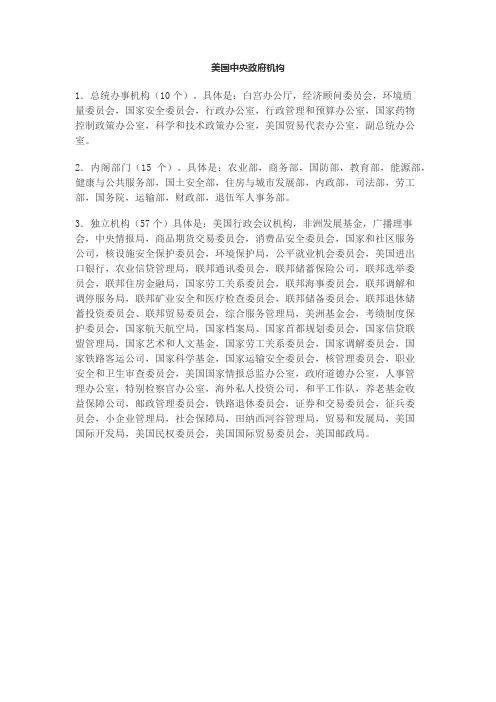
美国中央政府机构1.总统办事机构(10个)。
具体是:白宫办公厅,经济顾问委员会,环境质量委员会,国家安全委员会,行政办公室,行政管理和预算办公室,国家药物控制政策办公室,科学和技术政策办公室,美国贸易代表办公室,副总统办公室。
2.内阁部门(15个)。
具体是:农业部,商务部,国防部,教育部,能源部,健康与公共服务部,国土安全部,住房与城市发展部,内政部,司法部,劳工部,国务院,运输部,财政部,退伍军人事务部。
3.独立机构(57个)具体是:美国行政会议机构,非洲发展基金,广播理事会,中央情报局,商品期货交易委员会,消费品安全委员会,国家和社区服务公司,核设施安全保护委员会,环境保护局,公平就业机会委员会,美国进出口银行,农业信贷管理局,联邦通讯委员会,联邦储蓄保险公司,联邦选举委员会,联邦住房金融局,国家劳工关系委员会,联邦海事委员会,联邦调解和调停服务局,联邦矿业安全和医疗检查委员会,联邦储备委员会,联邦退休储蓄投资委员会、联邦贸易委员会,综合服务管理局,美洲基金会,考绩制度保护委员会,国家航天航空局,国家档案局、国家首都规划委员会,国家信贷联盟管理局,国家艺术和人文基金,国家劳工关系委员会,国家调解委员会,国家铁路客运公司,国家科学基金,国家运输安全委员会,核管理委员会,职业安全和卫生审查委员会,美国国家情报总监办公室,政府道德办公室,人事管理办公室,特别检察官办公室,海外私人投资公司,和平工作队,养老基金收益保障公司,邮政管理委员会,铁路退休委员会,证券和交易委员会,征兵委员会,小企业管理局,社会保障局,田纳西河谷管理局,贸易和发展局,美国国际开发局,美国民权委员会,美国国际贸易委员会,美国邮政局。
美国行政体制
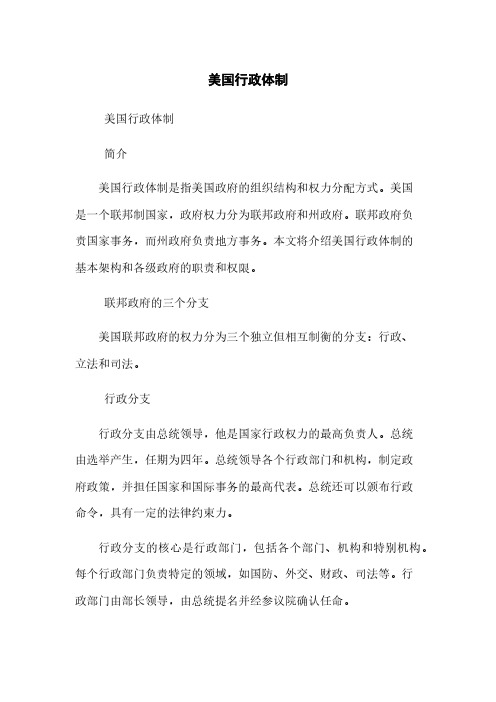
美国行政体制美国行政体制简介美国行政体制是指美国政府的组织结构和权力分配方式。
美国是一个联邦制国家,政府权力分为联邦政府和州政府。
联邦政府负责国家事务,而州政府负责地方事务。
本文将介绍美国行政体制的基本架构和各级政府的职责和权限。
联邦政府的三个分支美国联邦政府的权力分为三个独立但相互制衡的分支:行政、立法和司法。
行政分支行政分支由总统领导,他是国家行政权力的最高负责人。
总统由选举产生,任期为四年。
总统领导各个行政部门和机构,制定政府政策,并担任国家和国际事务的最高代表。
总统还可以颁布行政命令,具有一定的法律约束力。
行政分支的核心是行政部门,包括各个部门、机构和特别机构。
每个行政部门负责特定的领域,如国防、外交、财政、司法等。
行政部门由部长领导,由总统提名并经参议院确认任命。
立法分支立法分支由国会领导,由参议院和众议院组成。
国会是美国的立法机构,负责制定和通过法律。
参议院有100个议员,每个州分配两名议员,任期为六年。
众议院有435名议员,按照各州人口分配,任期为两年。
国会制定法律的过程通常需要总统签署成为法律。
如果总统否决,国会可以通过三分之二多数票覆盖总统的否决。
司法分支司法分支由最高法院及其下属的其他联邦法院组成。
最高法院是最高级的联邦法院,由九名大法官组成。
最高法院负责解释和审查法律的合宪性,并裁决有关法律争议的案件。
其判决具有最高的法律效力,对下级法院和各级政府具有约束力。
州政府和地方政府除了联邦政府的三个分支外,美国还有州政府和地方政府,负责地方事务的管理。
州政府美国由50个州组成,每个州都有自己的州政府,行使一定的自治权。
州政府的组织结构和职责类似于联邦政府的三个分支,包括州长、州议会和州法院。
州长是州政府的最高行政长官,负责领导州政府的行政部门,制定并实施州政策。
州议会由州参议院和州众议院组成,负责制定州法律。
州法院负责解释州法律,并处理州级的法律纠纷。
地方政府地方政府是指州政府下属的县政府、城市政府等,负责管理各个地方地区的事务。
美国政府组织架构注重制衡

美国政府组织架构注重制衡,联邦行政机构极为精简仅有14个部美国是一个联邦制国家。
美国联邦政府由国会、联邦行政机构和最高法院三部分组成。
一、国会根据美国宪法规定,国会是美国的最高立法机关,由参议院和众议院两院组成。
国会两院的议员由各州选民直接选举产生。
美国国会参议院由各州人民选举参议员组成,共有100名参议员,任期6年,每两年改选1/3。
众议员按各州人口比例产生,大约每50万人选出1名众议员,但每州至少有1名众议员,任期2年,期满全部改选。
美国国会每两年选举一次,一次与总统大选同时进行,另一次在同人次大选之间,即“中期选举”。
美国国会的主要职能是通过立法手段制订国家的政策;除立法外,还有修改宪法、调查法律执行情况、弹劾官员、对外宣战等职能。
其中参议院特有的权限是:批准总统与外国缔结的条约;批准总统任命的高级官员;审批弹劾案。
在特殊情况下,参议院有权选举副总统。
美国行政权属于美利坚合众国总统。
政府各部、委、局、署等一切机构,都向总统负责,受总统领导。
美国的政体是总统共和制。
总统是国家元首、联邦政府首脑兼武装部队总司令。
行政大权集中在总统手里。
总统有权任命高级官员,但需取得参议院的同意。
在外事活动方面,总统有权决定外交政策,委派驻外使节和特使,签订行政协定和缔结条约。
二、联邦行政机构联邦行政机构可分为三大类,即白宫直属机构、政府各部门及独立机构。
(1)白宫直属机构----白宫办公厅,国家安全委员会,行政管理和预算局。
(2)政府各部----国务院,财政部,国防部,司法部,内政部,农业部,商务部,劳工部,卫生与公众服务部,住房及城市发展部,交通部,能源部,教育部。
911之后,新设了国土安全部,共14个。
(3)独立机构----邮政总局,原子能委员会,国家航空和宇宙航行局,国际交流署,联邦储备局。
三、法院美国的联邦法院和州各有一套司法系统,没有从属关系。
联邦法院分为普通法院和特别法院两种不同的体系。
联邦普通法院的审理范围主要包括所有涉及美国宪法、联邦法律、国际关系、联邦商务,以及当联邦政府为诉讼之一方或两州之间的争执,或一州公民与另一州之间争执的案件。
美国联邦政府与各州政府间的权力结构和分配

美国联邦政府与各州政府间的权力结构和分配美国联邦政府与各州政府是美国政治体系中的两个主要政治实体。
它们之间的权力结构和分配是美国政治体系的核心之一。
根据美国宪法的规定,联邦政府和各州政府有各自的权力范围,但它们之间的权力分配又有很多灰色地带。
本文将探讨美国联邦政府与各州政府间的权力结构和分配。
权力结构首先,我们需要了解美国政治体系中联邦政府和各州政府的权力结构。
美国政治体系是一种联邦制政府,即政治权力由中央政府和地方政府共同拥有。
这种联邦制政府的特点是,中央政府和地方政府各自有自己的权力范围,但是,它们之间的权力分配需要通过宪法进行规定和约束。
联邦政府的权力主要来源于美国宪法。
根据美国宪法的规定,联邦政府的主要权力包括外交、国防、货币政策、联邦税收等。
联邦政府的权力可以通过立法、行政、司法等方式进行行使。
与联邦政府不同的是,各州政府的权力是由各自的州宪法规定的。
各州政府的权力主要包括关于地方事务的管理、教育、公共卫生等。
各州政府和地方政府的权力分配也有区别。
在一些州中,州政府比地方政府更强大;而在另一些州中,地方政府则更加强大。
权力分配了解了联邦政府和各州政府的权力结构之后,我们需要进一步探讨这些权力的分配。
一般来说,联邦政府和各州政府的权力范围是不同的,但是有一些权力是重叠的。
例如,治安、交通、环境保护等问题涉及到联邦政府和各州政府的双重权力。
在这些问题上,联邦政府和各州政府会协商,通过合作来解决问题。
此外,美国宪法还规定了一些限制,以控制联邦政府和各州政府的权力。
其中最重要的限制是宪法修正案。
宪法修正案是指通过美国宪法的修改来修改或加强保护某些权利。
例如,第十条修正案规定,各州有权行使联邦政府未行使的权力。
这意味着联邦政府不能侵犯各州的权力。
另一个重要的限制是最高法院的判决。
最高法院是美国司法体系的最高权力,它对联邦政府和各州政府的政策进行监督。
最高法院的判决具有法律效力,必须得到联邦政府和各州政府的遵守。
美国知识点总结政治

美国知识点总结政治美国政治体系概述美国政治体系是一个联邦制度体系,由联邦政府和50个州政府共同组成。
联邦政府分为三个独立的分支,分别是行政机构、立法机构和司法机构。
行政机构由总统和内阁组成,负责实施法律和政策。
立法机构由国会组成,包括参议院和众议院,负责制定和通过法律。
司法机构由最高法院和其他联邦法院组成,负责解释法律和处理司法案件。
美国政治体系的分权制衡设计使得各个政府机构之间相互制衡,保障了政府权力的相互监督和平衡。
美国政府机构总统制: 美国总统是国家元首和政府首脑,负责领导国家的行政事务,并拥有一定的法律和行政权力。
总统由选举产生,任期为4年,最多连任两届。
总统具有宣布国家紧急状态、签署行政命令、任命内阁成员和最高法院大法官等权力。
国会: 美国国会是立法机构,由参议院和众议院两个议院组成。
参议院每州两名议员,共100名,任期为6年;众议院根据各州人口分配议席,共435名,任期为2年。
国会负责制定和通过法律,同时对总统和政府机构进行监督和调查。
最高法院: 美国最高法院是联邦最高司法机构,负责解释宪法和处理联邦法律案件。
最高法院由九名大法官组成,任期终身。
最高法院具有裁定法律合宪性、解决州际纠纷和处理与联邦法律和宪法相关的案件等权力。
州政府: 美国有50个州,每个州都有自己的政府体系和宪法,由州长和州议会组成。
州政府负责管理州内事务,包括教育、卫生、交通、税收等。
州政府在许多事务上拥有独立的权力,例如制定州级法律、管理地方财政和监管州内公共事务等。
政党制度美国的政治制度是多党制度,两大主要政党是民主党和共和党。
这两个政党在国家政治中占据主导地位,并在国会和总统选举中竞争激烈。
除此之外,还有一些小型的政党和无党派人士在美国政治中活跃。
政党在选举中组织候选人、制定政策纲领、吸引选民支持,并在国会和政府中发挥影响力。
选举制度美国的总统由选举产生,采用选举人制度。
选举人根据各州的人口数量分配,共有538名选举人,每个州根据其参议院和众议院议席加上2名选举人进行分配。
美国联邦结构示意图

国会(立法)
↓
参议院,众议 院
美国联邦结构示意图
↘
总统(行政)
↓
内阁,其他机1月7日,美国举行中期选举。民主 党在国会议院中至少获得226个席位,夺回 1994失去的控制权。据观察家称,随着民 主党控制议院,未来两年布什总统(共和 党)在推动立法方面将遭遇更大阻力,面 临全新挑战,将进入其执政以来最为艰难 的时期在国内议题上难有较大作为,布什 成为跛脚总统的可能性将增大。
• 不会产生给本性影响。因为共和党和民主党都是 代表资产阶级不同阶层的政党,根本利益是一致 的。
• 材料三中罗伯特·盖茨将要成为国防部部长 要经历一个怎么样的过程。
• 答:总统提名→国会通过→出任国防部部长
• 中新网报,被指责让美国深陷战争泥潭的 伊拉克战争,拉姆斯菲尔德向布什提交辞
呈,这一消息经布什总统亲自证实,现任 德克萨斯农工大学校长,1991年至1993年 任职中央情报局局长的罗伯特·盖茨将出任 国防部部长。
• 从材料一中可以看出美国政府各机构之间 的关系体现了什么原则?这一原则是启蒙 运动时期哪一位思想家的思想?
• 答:三权分立,孟德斯鸠
• 材料二中观察家认为布什政府“面临全新挑战, 在国内议题上难有较大作为,布什总统成为跛脚 总统的可能性将增大”的理由是什么?这种变化 会不会对美国的政策长、产生根本根本性影响? 为什么?
• 答:理由:美国总统和国会之间是相互制约,相 互制衡的关系,布什总统属于共和党人,民主党 控制着议会。
美国政府组成
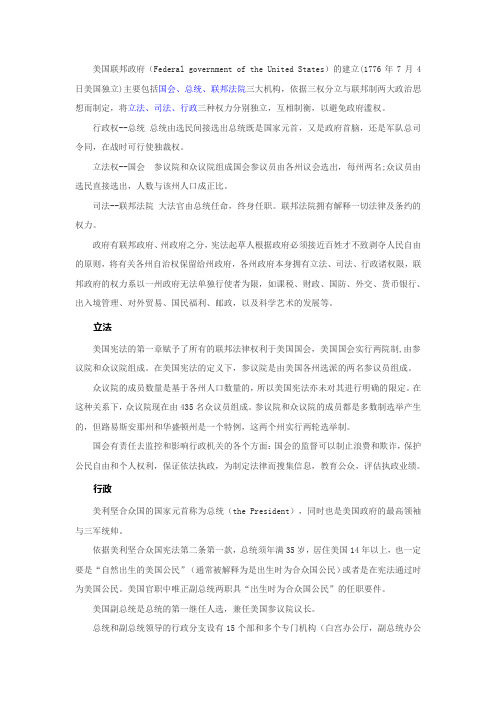
美国联邦政府(Federal government of the United States)的建立(1776年7月4日美国独立)主要包括国会、总统、联邦法院三大机构,依据三权分立与联邦制两大政治思想而制定,将立法、司法、行政三种权力分别独立,互相制衡,以避免政府滥权。
行政权--总统总统由选民间接选出总统既是国家元首,又是政府首脑,还是军队总司令同,在战时可行使独裁权。
立法权--国会参议院和众议院组成国会参议员由各州议会选出,每州两名;众议员由选民直接选出,人数与该州人口成正比。
司法--联邦法院大法官由总统任命,终身任职。
联邦法院拥有解释一切法律及条约的权力。
政府有联邦政府、州政府之分,宪法起草人根据政府必须接近百姓才不致剥夺人民自由的原则,将有关各州自治权保留给州政府,各州政府本身拥有立法、司法、行政诸权限,联邦政府的权力系以一州政府无法单独行使者为限,如课税、财政、国防、外交、货币银行、出入境管理、对外贸易、国民福利、邮政,以及科学艺术的发展等。
立法美国宪法的第一章赋予了所有的联邦法律权利于美国国会,美国国会实行两院制,由参议院和众议院组成。
在美国宪法的定义下,参议院是由美国各州选派的两名参议员组成。
众议院的成员数量是基于各州人口数量的,所以美国宪法亦未对其进行明确的限定。
在这种关系下,众议院现在由435名众议员组成。
参议院和众议院的成员都是多数制选举产生的,但路易斯安那州和华盛顿州是一个特例,这两个州实行两轮选举制。
国会有责任去监控和影响行政机关的各个方面:国会的监督可以制止浪费和欺诈,保护公民自由和个人权利,保证依法执政,为制定法律而搜集信息,教育公众,评估执政业绩。
行政美利坚合众国的国家元首称为总统(the President),同时也是美国政府的最高领袖与三军统帅。
依据美利坚合众国宪法第二条第一款,总统须年满35岁,居住美国14年以上,也一定要是“自然出生的美国公民”(通常被解释为是出生时为合众国公民)或者是在宪法通过时为美国公民。
分析美国的国家结构形式及其特点。

分析美国的国家结构形式及其特点。
美国的国家结构形式是一个联邦制,具有以下特点:1.联邦主权:美国的政治权力被分配给中央政府(联邦政府)和各州政府(州政府)两个层面。
联邦政府负责国家层面的事务,如国防、外交和货币政策等,而州政府负责各州的内部事务,如教育、交通和公共安全等。
两个层面的政府各具有相对独立的政治和行政权力。
2.权力分立:美国的政治体系采取权力分立的原则,将立法、行政和司法权力分别授予国会、行政部门和司法机构。
这种分立机构和权力的构架旨在实现权力的制衡和防止滥用。
3.双重主权:美国的国家结构体现了双重主权的特点,即联邦政府和各州政府分别享有一定的主权。
联邦政府在宪法规定的领域内行使权力,而各州政府在未被联邦政府明确规定的领域内保留一定的自主权。
4.权力分配和混合制衡:根据宪法,联邦政府拥有特定的权限,如制定外交政策、货币发行和国防等。
各州政府则保留了其他未被明确授予联邦政府的权力范围。
这种混合制衡使得不同层面的政府在政治和法律上相互制衡,确保权力分配的平衡性。
5.法治和宪政保障:美国的国家结构体现了法治和宪政的原则,所有政府行为都受到宪法和法律的约束。
宪法是最高法律文件,确保政府行使权力的合法性和公正性。
此外,美国的司法机构具有对政府行为进行合宪性审查的权力,以保障法治原则的实施。
美国的国家结构体现了分权、制衡和法治的价值观。
通过联邦制和权力分立原则,美国实现了中央与地方政府之间的分权和协调,并最大限度地保护公民的自由和权益。
这种制度设计为国家提供了灵活性和民主性,同时也带来了各种政治、经济和社会挑战。
美国行政制度

(三)中央情报局
1947年建立。法律上规定其职责是向国家安全 委员会提供情报,对各情报机构进行监督、协调, 对情报加以整理和评价以及为国家安全委员会获取 情报而执行其他职能和任务。实际上中央情报局的 主要任务是搜集情报、监督情报的传送,为此从事 国内外间谍活动、颠覆活动。中央情报局是个神秘 单位,历届美国总统很重视,但近年来屡屡失误, 引起国内各界的不满。
(二)内阁与议会的关系不同。
英国内阁成员必须是议会议员,内阁对议会 负责,议会有权投不信任票。而美国内阁成员则 不能是议员,也不对议会负责,国会也没有倒阁 权。美国内阁成员都注意总统的态度,对总统负 责,因为总统雇用了他,也可以解雇他。
美国内阁与英国内阁不同之处
(三)总统和内阁成员之间的关系不同。 英国首相与内阁成员之间是伙伴关系,他们都 是执政党的重要人物,一荣俱荣,一枯俱枯。而 美国总统与内阁成员之间是个人关系,甚至是一 种雇用关系,总统的着眼点是找到合适的人选, 完成其交给的任务,因此,他甚至可以任命不同 党派的人担任政府的要职,只要能完成任务。内 阁成员不可能否决总统的某项政策。
国防部
1949年将“国家军事机构”改名为国防部, 成为联邦政府正式的部。国防部的主要职权是根 据总统的命令组建、训练军队,提出有关军事方 面的政策建议和立法议案,具有对武装部队的指 挥权和新式武器制造权,统筹军事预算和作总统 的主要军事顾问,并直接领导参谋长联席会议。 国防部对总统对外政策的制定和实施有较大影响。
美国内阁与英国内阁不同之处
尽管在实际政治生活中存在着内阁这一机构, 但它与实行内阁制政府的国家(如英国)的内阁 有着本质的差别。这些差别是:
(一)内阁的性质不同。 英国内阁是一个集体决策机构,实行集体负 责制,首相虽然权力很大,但如果在某个重要问 题上受到内阁集体否决,他就有可能因此下台。
美国联邦政府由下列哪些机关组成
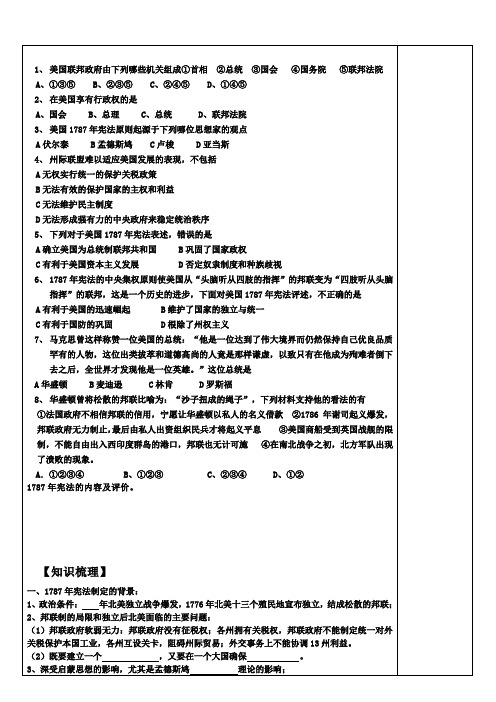
4、华盛顿在1787年给友人的一封信中谈到:“新英格兰出现的骚乱,我们商业上的不景气以及笼罩全国各地的那种普遍的低迷消沉情绪,在很大程度上归咎于最高权力机构的无权。”华盛顿这段话表明美国建国之初所要解决的首要问题是
A.人民起义不断B.大州与小州之间的矛盾
11、2005年10月19日,国务院发表的《中国的民主政治建设》白皮书指出:人类政治文明的发展史说明,世界并不存在唯一的、普遍使用的和绝对的民主模式。其实自古以来,各国政治发展史中都出现过典型的各具特色的政治模式,读下面示意图:
请回答:
(1)据图1,指出唐朝“三省六部”中三省的职能各是什么?三省六部制度具有什么特点?
(2)据图2,美国联邦政府机构的运行机制是什么?这一机制源自什么理论?
(3)中国古代和美国近代历史上的这两种政治模式在形式上有何共性?本质上相同吗?请说明判断的理由。
8、华盛顿曾将松散的邦联比喻为:“沙子扭成的绳子”,下列材料支持他的看法的有
①法国政府不相信邦联的信用,宁愿让华盛顿以私人的名义借款②1786年谢司起义爆发,邦联政府无力制止,最后由私人出资组织民兵才将起义平息③美国商船受到英国战舰的限制,不能自由出入西印度群岛的港口,邦联也无计可施④在南北战争之初,北方军队出现了溃败的现象。
A.英国《权利法案》B.德意志帝国宪法
C.美国1787年宪法D.法兰西第三共和国宪法
3.有学者指出:“那些为17世纪的大部分欧洲人难于理解和在当时的大不列颠尚未获得全胜的原则(自由与平等),已在新英格兰(英国在北美的殖民地)的法律上得到了全部承认,并被订于法律的条款之内。”对这句话的正确理解是
A.17世纪的新英格兰已是一个法制国家B.17世纪的英国还处于封建势力的统治之下
- 1、下载文档前请自行甄别文档内容的完整性,平台不提供额外的编辑、内容补充、找答案等附加服务。
- 2、"仅部分预览"的文档,不可在线预览部分如存在完整性等问题,可反馈申请退款(可完整预览的文档不适用该条件!)。
- 3、如文档侵犯您的权益,请联系客服反馈,我们会尽快为您处理(人工客服工作时间:9:00-18:30)。
President
The President is both the head of state and government, as well as the military commander-in-chief and chief diplomat. According to the Constitution, the President must "take care that the laws be faithfully executed", and "preserve, protect, and defend the Constitution". Vice president: President of the Senate and becomes President if the President is unable to serve.
Central Intelligence Agency(中情局 中情局) 中情局 The National Aeronautics and Space Administration (美国航天局 美国航天局) 美国航天局
The Judicial Branch—Federal Court
• The federal judges ,members of the Judicial Branch, are appointed by the President and confirmed by the Senate.
The structure of the U.S. Federal Government
Independence Hall—Symbol of U.S. Government
Symbols of the U.S. Government
About the Federal Government
• The federal government consists of three parts
Executive Office of the President
The Executive Office provides the president with the support the he or she needs to govern effectively which includes: White House Office(白宫 白宫) 白宫 National Critical Materials Council(国家重要物资委员会) (国家重要物资委员会) Office of Management and Budget(行政管理和预算局) (行政管理和预算局) Council on Environmental Quality(改善环境质量委员会) (改善环境质量委员会) Council of Economic Advisers(经济顾问委员会) (经济顾问委员会) Office of Science and Technology(科技局) (科技局) National Security Council(国家安全委员会) (国家安全委员会) Office of Administration(行政办公室) (行政办公室) Office of the U.S. Trade Representatives(美国贸易代表办公室) (美国贸易代表办公室) Office of National Drug Control Policy(国家麻醉品控制政策办公室) (国家麻醉品控制政策办公室)
The Supreme Court of the United States
The Powers of Congress
• The Constitution grants Congress "all legislative powers" in the national government., includes: • Coining money. • Maintaining a military. • Declaring war on other countries. • Regulating interstate and foreign commerce • controlling federal taxing and spending policies • make all laws which shall be necessary and proper • investigate and oversee the executive branch
Executive Branch
The executive branch of the Government is responsible for enforcing the laws of the land. It is the largest compared with the other two branches. The president is the leader of the executive branch. Besides the president and the vice president , there are departments ,independent agencies and commissions help to enforce the pocutive Departments
Department heads advise the President on policy issues and help execute those policies.
Fifteen Government Departments
Department of State(国务院 国务院) 国务院 Department of the Treasury(财政部 财政部) 财政部 Department of Defense(国防部 国防部) 国防部 Department of Justice(司法部) (司法部) Department of the Interior(内政部) (内政部) Department of Agriculture(农业部) (农业部) Department of Commerce(商务部) (商务部) Department of Labor(劳动部) (劳动部) Department of Health and Human Services(卫生部) (卫生部) Department of Housing and Urban Development(住房和城市房展部) (住房和城市房展部) Department of Transportation(交通部) (交通部) Department of Education(教育部) (教育部) Department of Veterans Affairs(退伍军人事务部) (退伍军人事务部) Department of Homeland and Security(国土安全部)( )(2003) (国土安全部)( )
The President's Cabinet
• The Cabinet includes the Vice President and the heads of 15 executive departments
President Obama at Cabinet meeting at the White House
Congress: Legislative branch. President: Executive branch. Federal Court: Judicial branch.
Congress
Congress has the power to make laws. It is bicameral (两院制) comprising the following two parts. Senate(参议院): 100 senators in total (each state has 2). 6-year serve term (every 2 year change 1/3).The vice president is the speaker of the Senate. House of Representative(众议院):435 members in total ( The number of every state’s seats based on the state’s population).
Federal Agencies & Commissions
There are hundreds of federal agencies and commissions charged with handling such responsibilities as managing America's space Program, protecting its forests, and gathering intelligence. Some Agencies:
